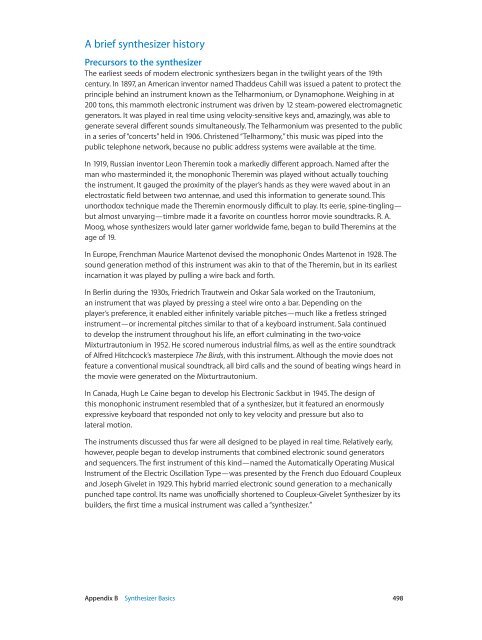Apple MainStage 3 Instruments - MainStage 3 Instruments
Apple MainStage 3 Instruments - MainStage 3 Instruments
Apple MainStage 3 Instruments - MainStage 3 Instruments
You also want an ePaper? Increase the reach of your titles
YUMPU automatically turns print PDFs into web optimized ePapers that Google loves.
A brief synthesizer history<br />
Precursors to the synthesizer<br />
The earliest seeds of modern electronic synthesizers began in the twilight years of the 19th<br />
century. In 1897, an American inventor named Thaddeus Cahill was issued a patent to protect the<br />
principle behind an instrument known as the Telharmonium, or Dynamophone. Weighing in at<br />
200 tons, this mammoth electronic instrument was driven by 12 steam-powered electromagnetic<br />
generators. It was played in real time using velocity-sensitive keys and, amazingly, was able to<br />
generate several different sounds simultaneously. The Telharmonium was presented to the public<br />
in a series of “concerts” held in 1906. Christened “Telharmony,” this music was piped into the<br />
public telephone network, because no public address systems were available at the time.<br />
In 1919, Russian inventor Leon Theremin took a markedly different approach. Named after the<br />
man who masterminded it, the monophonic Theremin was played without actually touching<br />
the instrument. It gauged the proximity of the player’s hands as they were waved about in an<br />
electrostatic field between two antennae, and used this information to generate sound. This<br />
unorthodox technique made the Theremin enormously difficult to play. Its eerie, spine-tingling—<br />
but almost unvarying—timbre made it a favorite on countless horror movie soundtracks. R. A.<br />
Moog, whose synthesizers would later garner worldwide fame, began to build Theremins at the<br />
age of 19.<br />
In Europe, Frenchman Maurice Martenot devised the monophonic Ondes Martenot in 1928. The<br />
sound generation method of this instrument was akin to that of the Theremin, but in its earliest<br />
incarnation it was played by pulling a wire back and forth.<br />
In Berlin during the 1930s, Friedrich Trautwein and Oskar Sala worked on the Trautonium,<br />
an instrument that was played by pressing a steel wire onto a bar. Depending on the<br />
player’s preference, it enabled either infinitely variable pitches—much like a fretless stringed<br />
instrument—or incremental pitches similar to that of a keyboard instrument. Sala continued<br />
to develop the instrument throughout his life, an effort culminating in the two-voice<br />
Mixturtrautonium in 1952. He scored numerous industrial films, as well as the entire soundtrack<br />
of Alfred Hitchcock’s masterpiece The Birds, with this instrument. Although the movie does not<br />
feature a conventional musical soundtrack, all bird calls and the sound of beating wings heard in<br />
the movie were generated on the Mixturtrautonium.<br />
In Canada, Hugh Le Caine began to develop his Electronic Sackbut in 1945. The design of<br />
this monophonic instrument resembled that of a synthesizer, but it featured an enormously<br />
expressive keyboard that responded not only to key velocity and pressure but also to<br />
lateral motion.<br />
The instruments discussed thus far were all designed to be played in real time. Relatively early,<br />
however, people began to develop instruments that combined electronic sound generators<br />
and sequencers. The first instrument of this kind—named the Automatically Operating Musical<br />
Instrument of the Electric Oscillation Type—was presented by the French duo Edouard Coupleux<br />
and Joseph Givelet in 1929. This hybrid married electronic sound generation to a mechanically<br />
punched tape control. Its name was unofficially shortened to Coupleux-Givelet Synthesizer by its<br />
builders, the first time a musical instrument was called a “synthesizer.”<br />
Appendix B Synthesizer Basics 498
















